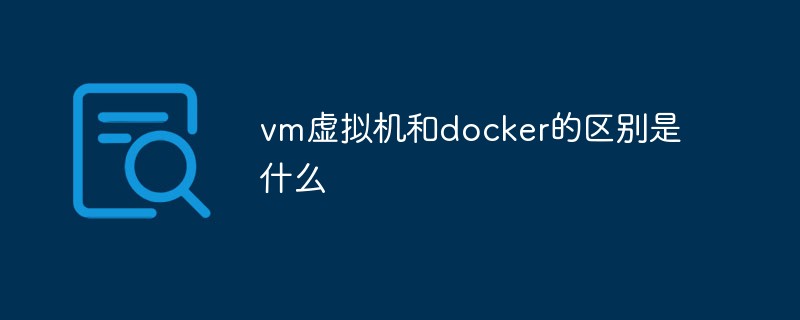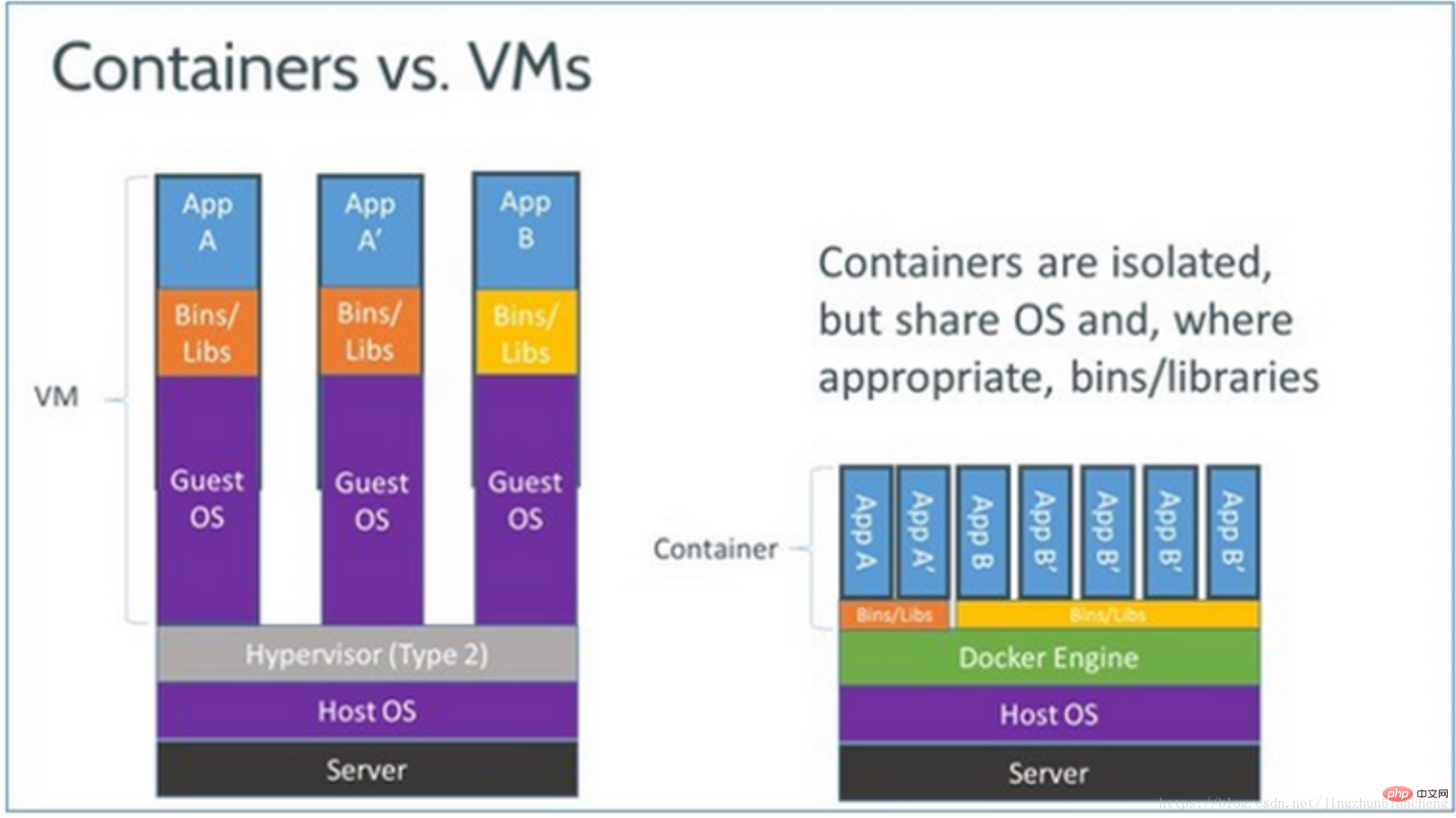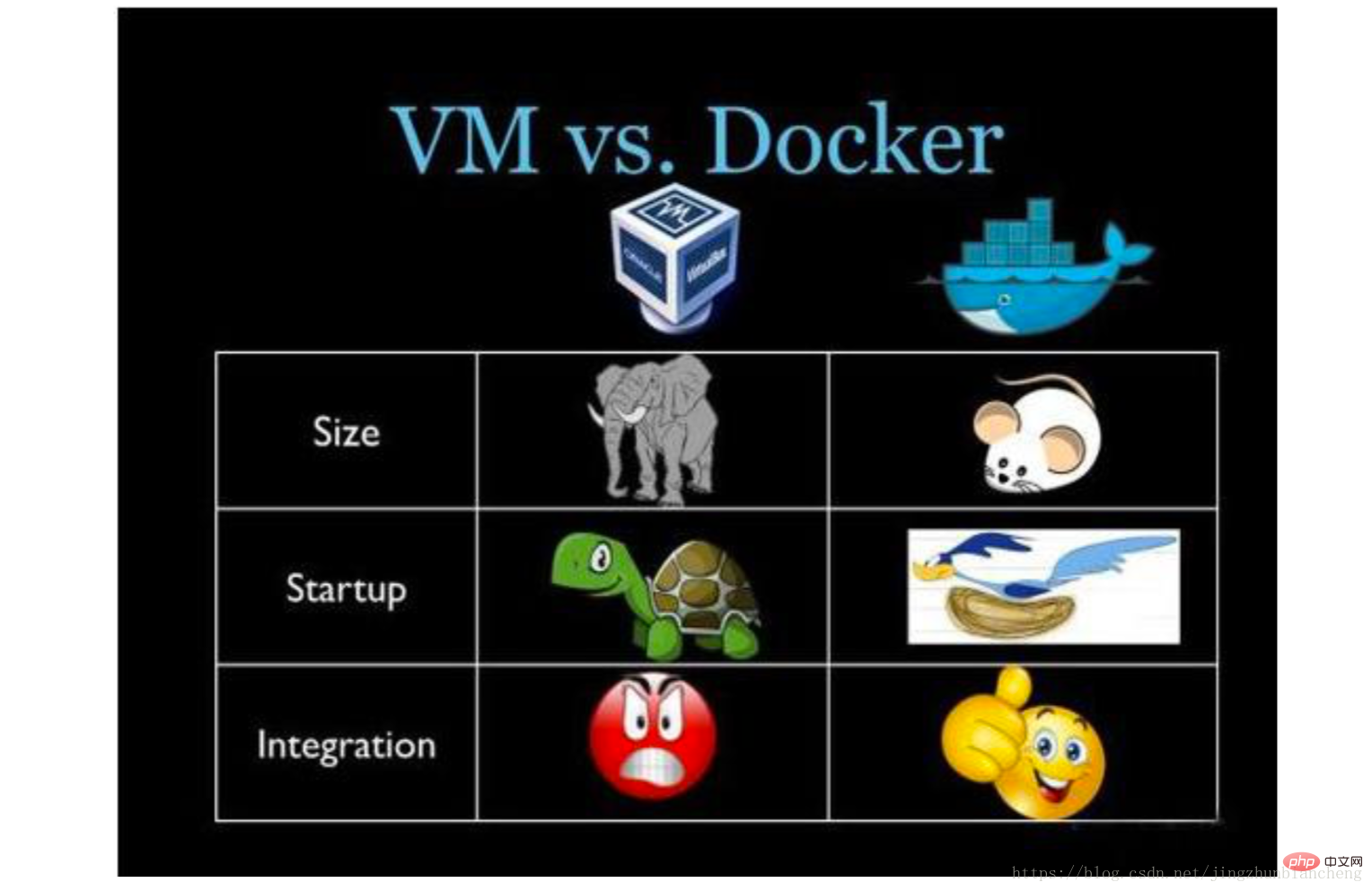What is the difference between vm virtual machine and docker
Difference: 1. Docker container provides process-based isolation, while VM virtual machine provides complete isolation of resources; 2. Docker uses the kernel of the host operating system, while VM virtual machine uses an independent kernel; 3 , Docker's startup speed is on the second level, and VM is on the minute level; 4. Docker's integration is better than VM.

The operating environment of this tutorial: linux5.9.8 system, docker-1.13.1&&VMware Workstation16.0.0.16894299 version, Dell G3 computer.
The difference between Docker and VM virtual machine
1. Essential difference:

VM (VMware) creates a virtual layer, virtualized operating system, and virtualized warehouse based on the host machine and host machine operating system, and then installs the application;
Container (Docker container) creates a Docker engine on the host machine and the host machine operating system, and then installs the application based on the engine.
Docker containers provide process-based isolation, while VM virtual machines provide complete isolation of resources. Containers use the kernel of the host operating system, while virtual machines use a separate kernel.
2. Differences in use:
 Size:
Size:
1. Ubuntu occupancy in the virtual machine Memory:
## Docker creates the Docker engine on the host machine's operating system and directly calls hardware resources on the host machine's operating system instead of virtualizing the operating system and hardware resources, so the operation speed is fast. This actually installs an ubuntu virtual machine and pulls a Docker ubuntu image file. You will know after running it. The difference is obvious. The startup speed of Docker is on the second level, and the VM is on the minute level: virtual It takes more than 2 minutes to start the computer, but Docker only takes 2 seconds.
This actually installs an ubuntu virtual machine and pulls a Docker ubuntu image file. You will know after running it. The difference is obvious. The startup speed of Docker is on the second level, and the VM is on the minute level: virtual It takes more than 2 minutes to start the computer, but Docker only takes 2 seconds.
Integration:
Docker’s integration is better than VM. 
1)
Users can "Dockerize" their programs in just a few minutes. Docker relies on the "copy-on-write" model, which makes it very fast to modify the application. It can be said that it reaches the realm of "the code is changed as you please".
Afterwards, you can create a container to run the application. Most Docker containers start in less than 1 second. Since the overhead of the hypervisor is removed, Docker containers have high performance. At the same time, more containers can be run on the same host, allowing users to make full use of system resources as much as possible.
2)
Logical classification of responsibilitiesUsing Docker, developers only need to care about the applications running in the container, while operation and maintenance personnel only need to care about how to manage the container. The purpose of Docker's design is to enhance the consistency between the development environment where developers write code and the production environment where applications are deployed. Thereby reducing the kind of "everything is normal during development, it must be an operation and maintenance problem (the test environment is normal, if there is a problem after going online, it must be an operation and maintenance problem)" 3)
Fast and efficient development life cycleOne of the goals of Docker is to shorten the cycle of code from development, testing to deployment and online operation, making your application portable, easy to build, and Easy to collaborate. (In layman’s terms, Docker is like a box that can contain many objects. If you need these objects, you can directly take them away from the big box without taking them one by one from the box.)
4)Encourage the use of service-oriented architecture
Docker also encourages service-oriented architecture and microservices architecture. Docker recommends that a single container only runs one application or process, thus forming a distributed application model. Under this model, applications or services can be represented as a series of internally interconnected containers, thus enabling distributed deployment Application, extension or debugging of the application becomes very simple, while also improving the introspection of the program. (Of course, you can run multiple applications in one container)
Recommended learning: "docker video tutorial"
The above is the detailed content of What is the difference between vm virtual machine and docker. For more information, please follow other related articles on the PHP Chinese website!

Hot AI Tools

Undresser.AI Undress
AI-powered app for creating realistic nude photos

AI Clothes Remover
Online AI tool for removing clothes from photos.

Undress AI Tool
Undress images for free

Clothoff.io
AI clothes remover

Video Face Swap
Swap faces in any video effortlessly with our completely free AI face swap tool!

Hot Article

Hot Tools

Notepad++7.3.1
Easy-to-use and free code editor

SublimeText3 Chinese version
Chinese version, very easy to use

Zend Studio 13.0.1
Powerful PHP integrated development environment

Dreamweaver CS6
Visual web development tools

SublimeText3 Mac version
God-level code editing software (SublimeText3)

Hot Topics
 How to exit the container by docker
Apr 15, 2025 pm 12:15 PM
How to exit the container by docker
Apr 15, 2025 pm 12:15 PM
Four ways to exit Docker container: Use Ctrl D in the container terminal Enter exit command in the container terminal Use docker stop <container_name> Command Use docker kill <container_name> command in the host terminal (force exit)
 How to copy files in docker to outside
Apr 15, 2025 pm 12:12 PM
How to copy files in docker to outside
Apr 15, 2025 pm 12:12 PM
Methods for copying files to external hosts in Docker: Use the docker cp command: Execute docker cp [Options] <Container Path> <Host Path>. Using data volumes: Create a directory on the host, and use the -v parameter to mount the directory into the container when creating the container to achieve bidirectional file synchronization.
 How to restart docker
Apr 15, 2025 pm 12:06 PM
How to restart docker
Apr 15, 2025 pm 12:06 PM
How to restart the Docker container: get the container ID (docker ps); stop the container (docker stop <container_id>); start the container (docker start <container_id>); verify that the restart is successful (docker ps). Other methods: Docker Compose (docker-compose restart) or Docker API (see Docker documentation).
 How to check the name of the docker container
Apr 15, 2025 pm 12:21 PM
How to check the name of the docker container
Apr 15, 2025 pm 12:21 PM
You can query the Docker container name by following the steps: List all containers (docker ps). Filter the container list (using the grep command). Gets the container name (located in the "NAMES" column).
 How to start mysql by docker
Apr 15, 2025 pm 12:09 PM
How to start mysql by docker
Apr 15, 2025 pm 12:09 PM
The process of starting MySQL in Docker consists of the following steps: Pull the MySQL image to create and start the container, set the root user password, and map the port verification connection Create the database and the user grants all permissions to the database
 How to start containers by docker
Apr 15, 2025 pm 12:27 PM
How to start containers by docker
Apr 15, 2025 pm 12:27 PM
Docker container startup steps: Pull the container image: Run "docker pull [mirror name]". Create a container: Use "docker create [options] [mirror name] [commands and parameters]". Start the container: Execute "docker start [Container name or ID]". Check container status: Verify that the container is running with "docker ps".
 How to update the image of docker
Apr 15, 2025 pm 12:03 PM
How to update the image of docker
Apr 15, 2025 pm 12:03 PM
The steps to update a Docker image are as follows: Pull the latest image tag New image Delete the old image for a specific tag (optional) Restart the container (if needed)
 How to create containers for docker
Apr 15, 2025 pm 12:18 PM
How to create containers for docker
Apr 15, 2025 pm 12:18 PM
Create a container in Docker: 1. Pull the image: docker pull [mirror name] 2. Create a container: docker run [Options] [mirror name] [Command] 3. Start the container: docker start [Container name]






